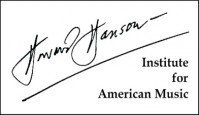The Howard Hanson Institute for American Music
History of the Howard Hanson Institute for American Music
When Howard Hanson retired in 1964 after serving 40 years as the director of the Eastman School of Music, his service to the University of Rochester was extended as the director of a newly created Institute of American Music. The purpose of the Institute, which was established as a University entity outside of the administrative structure of the School, was to continue Dr. Hanson’s tradition for promoting the understanding and appreciation of American music through performance, publication, and recording. The modest funds upon which the Institute has operated derive principally from royalties on compositions and recordings executed during Dr. Hanson’s tenure at the Eastman School.
When Howard Hanson died in 1981, his wife Peggy assumed the role of the Institute’s director for a short time. However, as her health declined over the years, the Institute became less active. Following Mrs. Hanson’s death in 1996, the Institute was reorganized and new board members named.
About Howard Hanson
By Ruth Watanabe
Howard Hanson (1896-1981) was a composer, conductor, musical statesman, educator, and for 40 years (1924-1964), director of the Eastman School of Music.
Born in Wahoo, Nebraska, on October 28, 1896, to Swedish-American parents who had settled in the Midwest, he was a child prodigy whose music lessons were begun with his mother. He continued his professional training at Lutheran College (Wahoo), the University of Nebraska School of Music (Lincoln), the Institute of Music Art (New York), and the School of Music, Northwestern University (Evanston), earning his Bachelor’s degree in 1916. That year he was appointed to the faculty of the College of the Pacific in San Jose, California, where three years later he became Dean of the School of Fine Arts.
A declared neo-Romanticist, Hanson wrote music at once tuneful, vigorous, and accessible. Hanson’s earliest compositions, dating from around 1914, included songs, piano pieces, and two symphonic works, and culminated in his music for the California Forest Play of 1920. In 1923 he won the Prix de Rome with which he took up residence in Italy as the first American composer to be named a Rome Fellow. While there he completed his first symphony (“Nordic”), whose first performance by the Augusteo Orchestra he conducted in Rome, and wrote his great choral piece, The Lament for Beowulf, his String Quartet, and his two symphonic poems, North and West and Lux Aeterna.
Early in 1924 Hanson returned to the United States to lead the New York Symphony Orchestra in his North and West and to conduct the Rochester Philharmonic Orchestra in the American premiere of his Nordic Symphony. Upon the invitation of President Rush Rhees and George Eastman, he became the second director of the recently established Eastman School of Music, taking office shortly before his 28th birthday.
During the ensuing decades Hanson became one of the country’s most influential music educators. The Eastman School under his leadership developed into an institution in which students could receive a well-rounded education while concentrating upon their professional studies.
Perhaps his greatest overall influence upon music was as protagonist of American culture. During the early decades of the century, music in America was dominated by European music and Old World influences. As an American composer striving to be heard, Hanson was fired with zeal to bring native music to the fore. In 1925, in a daring move for those years, he initiated the American Composers Concerts, during which works by our own writers were performed, many for the first time, by professional musicians from the Rochester Philharmonic Orchestra, assisted by the School’s artist faculty and advanced students. In 1930 he began an even more ambitious project: the annual Festivals of American Music, which continued through 1971, by which time more than 200 compositions had been given their first performance, with the composers being present for the rehearsals and the public concerts. While it may appear that the greatest emphasis was upon orchestral music, each Festival also featured a ballet, opera, chamber and choral music. Hanson’s inclusion of American works at symphony concerts he offered as guest conductor with major symphonies throughout the country and his national radio broadcasts over the NBC network during the 1930s and 1940s helped to create a large audience for contemporary works by our own composers. He was justly called the Dean of American Composers and spokesman for music in America.
The outward signs of recognition accorded him by the public took the form of citations for his contributions to the quality of American life and culture, 34 honorary doctorates, election into the most prestigious national and international organizations, and buildings named in his honor. In 1996, we at the Eastman School of Music as well the country at large celebrated his glorious career on what would have been his 100th birthday and we continue to invite all music-lovers to share in his music.


